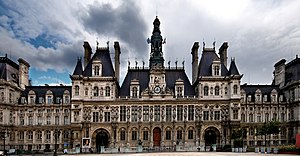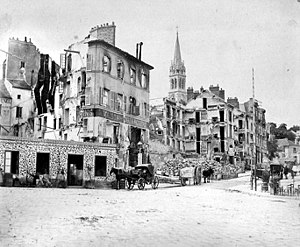Country:
Region:
City:
Latitude and Longitude:
Time Zone:
Postal Code:
IP information under different IP Channel
ip-api
Country
Region
City
ASN
Time Zone
ISP
Blacklist
Proxy
Latitude
Longitude
Postal
Route
Luminati
Country
ASN
Time Zone
Europe/Paris
ISP
Accenture SAS
Latitude
Longitude
Postal
IPinfo
Country
Region
City
ASN
Time Zone
ISP
Blacklist
Proxy
Latitude
Longitude
Postal
Route
db-ip
Country
Region
City
ASN
Time Zone
ISP
Blacklist
Proxy
Latitude
Longitude
Postal
Route
ipdata
Country
Region
City
ASN
Time Zone
ISP
Blacklist
Proxy
Latitude
Longitude
Postal
Route
Popular places and events near this IP address

Paris
Capital and largest city of France
Distance: Approx. 7 meters
Latitude and longitude: 48.85666667,2.35222222
Paris (French pronunciation: [paʁi] ) is the capital and largest city of France. With an official estimated population of 2,102,650 residents in January 2023 in an area of more than 105 km2 (41 sq mi), Paris is the fourth-largest city in the European Union and the 30th most densely populated city in the world in 2022. Since the 17th century, Paris has been one of the world's major centres of finance, diplomacy, commerce, culture, fashion, and gastronomy.

Second French Empire
Empire in France from 1852 to 1870
Distance: Approx. 24 meters
Latitude and longitude: 48.85638889,2.35222222
The Second French Empire, officially the French Empire, was the government of France from 2 December 1852 to 4 September 1870 between the Second and the Third French Republics. Ruled by Louis-Napoléon Bonaparte (Napoleon III), the period was one of significant achievements in infrastructure and economy, while France reasserted itself as the dominant power in Europe. Historians in the 1930s and 1940s disparaged the Second Empire as a precursor of fascism, but by the late 20th century it was re-evaluated as an example of a modernizing regime.

Place de l'Hôtel-de-Ville – Esplanade de la Libération
Parisian square
Distance: Approx. 61 meters
Latitude and longitude: 48.85666667,2.35138889
The Place de l'Hôtel-de-Ville – Esplanade de la Libération is a public square in the 4th arrondissement of Paris, located in front of the Hôtel de Ville. Before 1802, it was called the Place de Grève. The French word grève refers to a flat area covered with gravel or sand situated on the shores or banks of a body of water.

Siege of Paris (1870–1871)
Part of the Franco-Prussian War
Distance: Approx. 31 meters
Latitude and longitude: 48.8566,2.3518
The siege of Paris took place from 19 September 1870 to 28 January 1871 and ended in the capture of the city by forces of the various states of the North German Confederation, led by the Kingdom of Prussia. The siege was the culmination of the Franco-Prussian War, which saw the Second French Empire attempt to reassert its dominance over continental Europe by declaring war on the North German Confederation. The Prussian-dominated North German Confederation had recently emerged victorious in the Austro-Prussian War of 1866, which led to the questioning of France's status as the dominant power of continental Europe.

Hôtel de Ville, Paris
Town hall of Paris, France
Distance: Approx. 30 meters
Latitude and longitude: 48.8564,2.3525
The Hôtel de Ville (French pronunciation: [otɛl də vil], City Hall) is the city hall of Paris, France, standing on the Place de l'Hôtel-de-Ville – Esplanade de la Libération in the 4th arrondissement. The south wing was originally constructed by Francis I beginning in 1535 until 1551. The north wing was built by Henry IV and Louis XIII between 1605 and 1628.

Timeline of Paris
Distance: Approx. 22 meters
Latitude and longitude: 48.85666667,2.35194444
The following is a timeline of the history of the city of Paris, France.

International Federation of Film Archives
French Organization
Distance: Approx. 2 meters
Latitude and longitude: 48.856614,2.352222
The International Federation of Film Archives (French: Fédération internationale des archives du film, FIAF) was founded in Paris in 1938 by the Cinémathèque Française, the Reichsfilmarchiv in Berlin, the British Film Institute and the Museum of Modern Art in New York City. FIAF brings together the world's leading institutions in the field of moving picture heritage. Its affiliates describe themselves as "the defenders of the twentieth century's own art form".

Siege of Paris (1590)
Part of the French Wars of Religion
Distance: Approx. 31 meters
Latitude and longitude: 48.8566,2.3518
The siege of Paris (7 May – 30 August 1590) took place during the French Wars of Religion when the French Royal Army under Henry of Navarre, and supported by the Huguenots, failed to capture the city of Paris from the Catholic League. Paris was finally relieved from the siege by an international Catholic-Spanish army under the command of Alexander Farnese, Duke of Parma.

Café de la Gare
Theatre in Paris, France
Distance: Approx. 88 meters
Latitude and longitude: 48.8573719,2.3524656
The Café de la Gare is a dinner theater located at 41, rue du Temple in the 4th arrondissement of Paris. It lies in a square hidden between Notre Dame de Paris and the historic Marais district. It was originally created in 1968 by a close-knit group of comedy actors who fixed up an old factory near the Gare de Paris-Montparnasse in the 14th arrondissement.
Autonomous Port of Paris
Port in France
Distance: Approx. 1 meters
Latitude and longitude: 48.8566,2.3522
The Autonomous Port of Paris (French: "Port autonome de Paris") is a public institution in France that was set up in 1970. Its mission is to develop waterway traffic and port activity by creating, maintaining and handling the commercial operation of 70 sites in Ile-de-France. It is the second largest inland port in Europe after Duisburg.

Siege of Paris (1429)
1429 battle of the Hundred Years' War
Distance: Approx. 31 meters
Latitude and longitude: 48.8566,2.3518
The siege of Paris was an assault undertaken in September 1429 during the Hundred Years' War by the troops of the recently crowned King Charles VII of France, with the notable presence of Joan of Arc, to take the city held by the English and Burgundians. King Charles's French troops failed to enter Paris, defended by the governor Jean de Villiers de L'Isle-Adam and the provost Simon Morhier, with the support of much of the city's population.

2024 Summer Olympics opening ceremony
Olympic event
Distance: Approx. 7 meters
Latitude and longitude: 48.85666667,2.35222222
The opening ceremony of the 2024 Summer Olympics took place on 26 July 2024 across Paris, beginning at 19:30 CEST (17:30 UTC). As mandated by the Olympic Charter, the proceedings included an artistic program showcasing the culture of the host country and city, the parade of athletes and the lighting of the Olympic cauldron. The Games were formally opened by the president of France, Emmanuel Macron.
Weather in this IP's area
overcast clouds
11 Celsius
10 Celsius
10 Celsius
12 Celsius
1028 hPa
84 %
1028 hPa
1022 hPa
10000 meters
3.6 m/s
90 degree
100 %
07:39:27
17:28:45